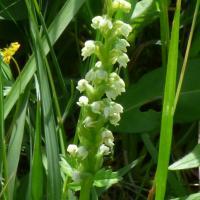 A better Tuesday than the last two. The rain kept away, there were fleeting glimpses of the sun and the minibus, driven by Julia, headed out on the much loved and familiar route to the Dales. Our destination was the recently extended YWT Ashes Pasture Reserve near Ribblehead. This is a diverse grassland area with acid pasture, fen meadows and calcareous flushes which hosts a wealth of species. In view of safety consideration we were dropped at the site and the minibus then parked some distance away.
A better Tuesday than the last two. The rain kept away, there were fleeting glimpses of the sun and the minibus, driven by Julia, headed out on the much loved and familiar route to the Dales. Our destination was the recently extended YWT Ashes Pasture Reserve near Ribblehead. This is a diverse grassland area with acid pasture, fen meadows and calcareous flushes which hosts a wealth of species. In view of safety consideration we were dropped at the site and the minibus then parked some distance away.
Twenty four species in flower had been recorded before we left the entrance area with its newly provided seating, information board and audio speaker. As there are no permanent paths we tried to keep to the walked trails and to avoid trampling on the less common plants - not an easy task. Almost immediately Common and Heath Spotted orchids and their hybrids were seen scattered throughout the vegetation. After meeting a representative of YWT our intended direction was abandoned and we followed his instructions. So began our search for the Small White Orchid. This plant has eluded us on previous searches in the nearby area. Today, after walking through long, damp grass, on some uneven ground and negotiating a relatively steep bank, (at least for some of us), we found four beautiful specimens. The "small" refers to the bell shaped flowers just 2-4mm across, not to the height of the plant. Within a couple of metres was another gem, a not fully opened Greater Butterfly Orchid and not so far away a Fragrant Orchid. Searching continued but eventually all arrived at the bottom of the slope where remaining lunches were eaten. Whether walking, eating or resting there was so much to see.
Next came a walk through a carpet of colour across glorious hay meadows with innumerable grasses, buttercups, red clover, yellow rattle, eyebright and pignut just some of the sward. Marginal areas produced Melancholy Thistle, Angelica and Meadowsweet. That this area of beauty stills remains is due to the farmer who ignored government directives to add fertilisers to the fields to improve the yield. An excellent decision.
Seven of the party chose to follow an additional circular route which became wetter and more uneven as we progressed. Bird's eye Primrose and Butterwort in profusion were our reward. For myself, the downside of this extension was the large number of sedges which I could not identify. The other four members were waiting for us and we retraced our steps towards the starting point along a route with ever more orchids of the spotted types in many shades many of which were likely to be hybrids. Unfortunately while negotiating the wet, grassy bank Margaret fell. After resting she was ably assisted to the minibus by Amanda and Julia. The seats at the entrance were appreciated while the minibus was fetched.
So many plants were seen. A total of over a hundred were recorded in flower and there were no doubt more that I missed. In spite of this huge selection insect numbers were low; only three butterflies, Green Veined White, Peacock and Small Heath were seen.
Twenty birds were recorded including sandpiper, goosander, meadow pipit and reed bunting.Some people heard the cuckoo. I enjoyed the sound of a curlew bubbling as we squelched on the circular route.
Thanks to Julia for leading, assisted by Amanda, and for driving including the extra sections at beginning and end of the main route which were so helpful to many of us.
See the photos here.
Alice
PS. On return Margaret felt well enough to be able to drive herself home but reported on Wednesday that Xrays reveal a fracture to her ankle. All wish her a speedy recovery.
